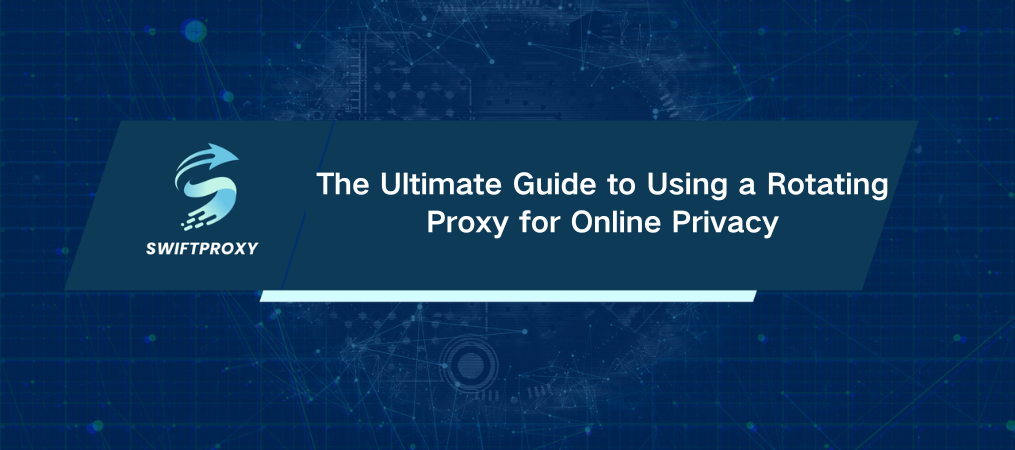The Ultimate Guide to Using a Rotating Proxy for Online Privacy

In a world where online privacy is more important than ever, the ability to protect your identity while accessing the web is crucial. Enter a rotating proxy—an essential tool that can elevate your online strategy. Whether you're looking to scrape data, manage multiple accounts, or just stay anonymous online, a rotating proxy is your best ally.
But what exactly is it, and why should you care? Let's dive in.
An Introduction to Rotating Proxy
A rotating proxy is a type of proxy server that changes your IP address after each request or on a set schedule. Each time you connect to the internet, the proxy assigns you a new IP address, effectively masking your real identity and location. This continuous IP rotation makes it difficult for websites to track your activities or block your access. It provides a seamless way to maintain anonymity and bypass online restrictions.
There are three main types of rotating proxies:
· Residential Proxy: An IP from a real user, providing better anonymity.
· Datacenter Proxy: An IP from a data center—faster and more cost-effective.
· Mobile Proxy: An IP from a mobile device, offering the highest level of stealth.
Why Choose a Rotating Proxy
You might be wondering, "Why not just use a static IP?" Here's why a rotating proxy is the game-changer:
1. Avoid Getting Blocked: When you're scraping data or running tests, some websites can block your IP if they detect unusual activity. A rotating proxy constantly changes your IP, making it nearly impossible for sites to recognize you as a bot.
2. Boost Your Anonymity: A rotating proxy hides your real IP address and prevents tracking. By using millions of different IPs, you reduce the chances of being flagged as suspicious.
3. Scale Your Projects: Whether it's web scraping or running multiple social media accounts, a rotating proxy helps you scale quickly. By routing requests through different IPs, you avoid hitting rate limits and manage tasks efficiently.
4. Bypass CAPTCHAs: When you're scraping or testing, CAPTCHAs can be a huge roadblock. A rotating proxy helps you circumvent this by sending requests from a different IP each time, reducing the chances of encountering CAPTCHAs.
How IP Rotation Functions
At its core, a rotating proxy changes your IP address every time you make a new connection. This means you can send hundreds (or even thousands) of requests, and each one will appear to come from a different IP.
For tasks that require a consistent IP, many proxy providers, like Swiftproxy, offer sticky sessions—allowing you to keep the same IP for a specified amount of time, anywhere from 1 minute to 24 hours.
The Main Types of Rotating Proxies
Here's a breakdown of your options:
1. Rotating Datacenter Proxy: Fast and reliable. This is perfect for SEO research, market analysis, and eCommerce browsing. It's cost-effective but may lack precise geo-targeting.
2. Rotating Residential Proxy: This is an IP from a real person, so it’s perfect for tasks requiring specific geographic targeting. It's slower than a datacenter proxy, but its stealth and precision make it invaluable for tasks like web scraping and ad verification.
3. Rotating Mobile Proxy: The top-tier option. A mobile proxy is incredibly stealthy, with a very low risk of detection. It's ideal for running multiple eCommerce accounts, managing ads, or testing mobile apps.
4. Rotating ISP Proxy: This proxy combines the authenticity of residential IPs with the speed of datacenter IPs. It's perfect for accessing sites with heavy anti-bot measures or running traffic-intensive tasks.
How to Make the Most of a Rotating Proxy
It's easier than you think. Here's a step-by-step guide to setting up and using a rotating proxy effectively:
1. Select a Trusted Provider: Your proxy provider is critical. Look for a service with a large IP pool, great uptime, and excellent support. A quality provider ensures your proxy won't fail you mid-task.
2. Set Rotation Intervals: Decide how often you want your IP to rotate. You can choose to rotate after every request or at set time intervals.
3. Integrate with Your Tools: Add the proxy details to your scraping tools, browsers, or scripts. Most proxy providers offer straightforward integration guides.
4. Track Performance: Keep track of your proxy's performance. Make sure you're hitting your target success rate, and adjust rotation settings if necessary.
5. Choose Smart Rotation Settings: Don't overdo it. Frequent IP rotations can seem suspicious. Select a rotation schedule that works with your specific use case.
The Best Rotating Proxy on the Market
Looking for top-tier rotating proxies? You've come to the right place. Here's what makes our proxies stand out:
1. Speed: Our residential proxies have an average response time of under 0.58 seconds. Datacenter proxies are even faster, with response times under 0.3 seconds.
2. Success Rate: Our residential IPs boast a 99.5% success rate. Mobile proxies have an impressive 99.5% success rate, ensuring you never miss a beat.
3. No Subscription Needed: Our pay-as-you-go plans give you flexibility, letting you buy as many proxy GBs as you need.
4. Massive Pool: With over 70 million rotating residential, mobile, datacenter, and ISP proxies, we have the coverage you need.
In Conclusion
A rotating proxy is a valuable tool for anyone focused on web scraping, market research, ad verification, or maintaining online anonymity. With the right provider, you can scale your operations without the risk of being blocked or detected.
By understanding and implementing a rotating proxy, you can create a smoother and more efficient online experience. Protect your identity, automate your tasks, and access the data you need without restrictions.

















































